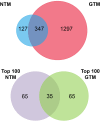Comparison of the extracellular vesicle proteome between glaucoma and non-glaucoma trabecular meshwork cells
- PMID: 38223904
- PMCID: PMC10785745
- DOI: 10.3389/fopht.2023.1257737
Comparison of the extracellular vesicle proteome between glaucoma and non-glaucoma trabecular meshwork cells
Abstract
Introduction: Extracellular matrix (ECM) materials accumulate in the trabecular meshwork (TM) tissue of patients with glaucoma, which is associated with a decrease in aqueous humor outflow and therefore an increase in intraocular pressure. To explore a potential mechanism for ECM regulation in the TM, we purified extracellular vesicles (EVs) from conditioned media of differentiated TM cells in culture isolated from non-glaucomatous and glaucomatous human donor eyes.
Methods: EVs were purified using the double cushion ultracentrifugation gradient method. Fractions containing EV markers CD9 and TSG101 were analyzed using nanoparticle tracking analysis to determine their size and concentration. We then determined their proteomic cargo by mass spectrometry and compared protein profiles of EVs between normal and glaucomatous TM cells using PANTHER. Key protein components from EV preparations were validated with Western blotting.
Results: Results showed changes in the percentage of ECM proteins associated with EVs from glaucomatous TM cells compared to non-glaucomatous TM cells (5.7% vs 13.1% respectively). Correspondingly, we found that two ECM-related cargo proteins found across all samples, fibronectin and EDIL3 were significantly less abundant in glaucomatous EVs (<0.3 fold change across all groups) compared to non-glaucomatous EVs.
Discussion: Overall, these data establish that ECM materials are prominent proteomic cargo in EVs from TM cells, and their binding to EVs is diminished in glaucoma.
Keywords: conventional outflow pathway; extracellular matrix; extracellular vesicles; glaucoma; trabecular meshwork.
Conflict of interest statement
Conflict of interest The authors declare that the research was conducted in the absence of any commercial or financial relationships that could be construed as a potential conflict of interest.
Figures




Similar articles
-
Comparative analysis of traction forces in normal and glaucomatous trabecular meshwork cells within a 3D, active fluid-structure interaction culture environment.Acta Biomater. 2024 May;180:206-229. doi: 10.1016/j.actbio.2024.04.021. Epub 2024 Apr 17. Acta Biomater. 2024. PMID: 38641184
-
Extracellular matrix in the trabecular meshwork: intraocular pressure regulation and dysregulation in glaucoma.Exp Eye Res. 2015 Apr;133:112-25. doi: 10.1016/j.exer.2014.07.014. Exp Eye Res. 2015. PMID: 25819459 Free PMC article. Review.
-
Glaucomatous cell derived matrices differentially modulate non-glaucomatous trabecular meshwork cellular behavior.Acta Biomater. 2018 Apr 15;71:444-459. doi: 10.1016/j.actbio.2018.02.037. Epub 2018 Mar 7. Acta Biomater. 2018. PMID: 29524673 Free PMC article.
-
Thrombospondin-2 is up-regulated by TGFβ2 and increases fibronectin expression in human trabecular meshwork cells.Exp Eye Res. 2019 Dec;189:107820. doi: 10.1016/j.exer.2019.107820. Epub 2019 Oct 4. Exp Eye Res. 2019. PMID: 31589839
-
Extracellular matrix in the trabecular meshwork.Exp Eye Res. 2008 Apr;86(4):543-61. doi: 10.1016/j.exer.2008.01.013. Epub 2008 Jan 25. Exp Eye Res. 2008. PMID: 18313051 Free PMC article. Review.
Cited by
-
Cell Type-Specific Extracellular Vesicles and Their Impact on Health and Disease.Int J Mol Sci. 2024 Feb 27;25(5):2730. doi: 10.3390/ijms25052730. Int J Mol Sci. 2024. PMID: 38473976 Free PMC article. Review.
References
Grants and funding
LinkOut - more resources
Full Text Sources
Molecular Biology Databases

